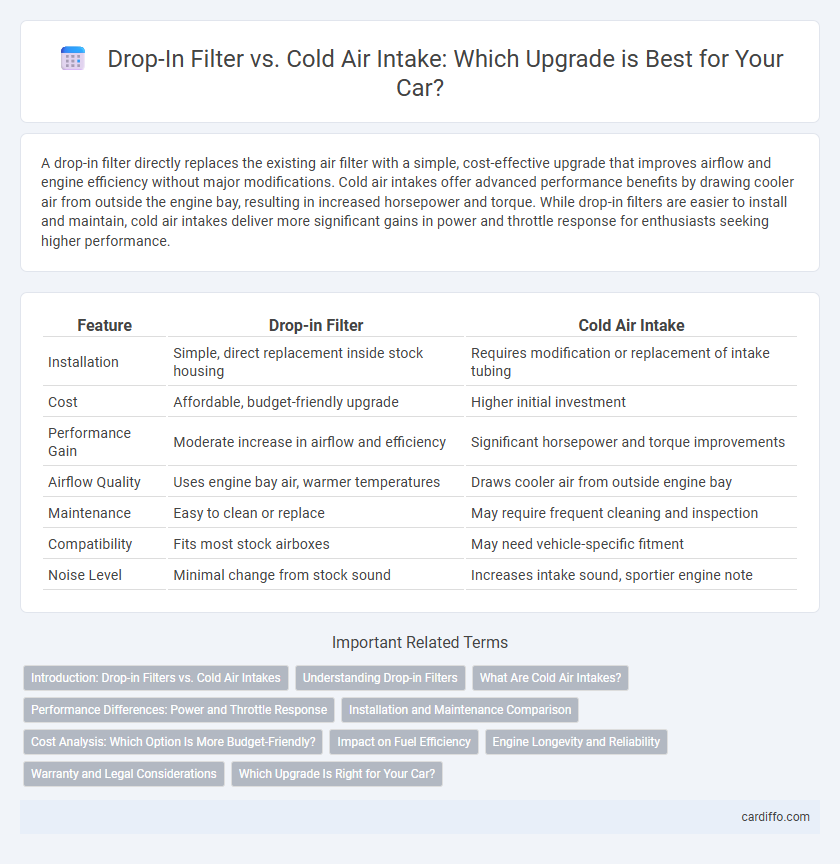A drop-in filter directly replaces the existing air filter with a simple, cost-effective upgrade that improves airflow and engine efficiency without major modifications. Cold air intakes offer advanced performance benefits by drawing cooler air from outside the engine bay, resulting in increased horsepower and torque. While drop-in filters are easier to install and maintain, cold air intakes deliver more significant gains in power and throttle response for enthusiasts seeking higher performance.
Table of Comparison
| Feature | Drop-in Filter | Cold Air Intake |
|---|---|---|
| Installation | Simple, direct replacement inside stock housing | Requires modification or replacement of intake tubing |
| Cost | Affordable, budget-friendly upgrade | Higher initial investment |
| Performance Gain | Moderate increase in airflow and efficiency | Significant horsepower and torque improvements |
| Airflow Quality | Uses engine bay air, warmer temperatures | Draws cooler air from outside engine bay |
| Maintenance | Easy to clean or replace | May require frequent cleaning and inspection |
| Compatibility | Fits most stock airboxes | May need vehicle-specific fitment |
| Noise Level | Minimal change from stock sound | Increases intake sound, sportier engine note |
Introduction: Drop-in Filters vs. Cold Air Intakes
Drop-in filters and cold air intakes both serve to improve engine air flow but differ significantly in design and performance impact. Drop-in filters replace the stock air filter element without altering the intake system, offering a cost-effective upgrade with modest gains in filtration and airflow. Cold air intakes replace the entire intake assembly, optimizing air volume and temperature, resulting in increased horsepower, torque, and enhanced engine efficiency.
Understanding Drop-in Filters
Drop-in filters offer a straightforward upgrade by replacing the factory air filter without altering the intake system, ensuring easy installation and maintenance. They improve filtration efficiency and airflow compared to stock filters, contributing to better engine performance and fuel economy. Unlike cold air intakes, drop-in filters retain the original airbox design, minimizing the risk of water ingestion and eliminating the need for additional components.
What Are Cold Air Intakes?
Cold air intakes are aftermarket automotive components designed to increase engine performance by allowing cooler, denser air to enter the engine's combustion chamber. Unlike drop-in filters, which simply replace the factory air filter and fit within the existing airbox, cold air intakes typically include a custom air filter, a longer intake tube, and a redesigned airbox to draw air from outside the engine compartment. This upgrade enhances airflow and can improve horsepower, torque, and fuel efficiency by optimizing the engine's air intake temperature and volume.
Performance Differences: Power and Throttle Response
Drop-in filters minimally improve power by enhancing airflow compared to stock filters but offer limited gains in throttle response due to their design constraints. Cold air intakes significantly boost horsepower and torque by directing cooler, denser air into the engine, resulting in sharper throttle response and improved acceleration. Performance metrics show cold air intakes can increase power output by up to 10-15%, whereas drop-in filters typically yield less than 5%.
Installation and Maintenance Comparison
Drop-in filters offer a simple, tool-free installation process compatible with most stock airboxes, requiring minimal maintenance like periodic cleaning or replacement every 15,000 miles. Cold air intakes involve more complex installation, often needing custom fittings and adjustments to ensure proper airflow, making maintenance slightly more intensive with regular inspection for debris and occasional filter oiling. The ease of installation and lower maintenance demands make drop-in filters ideal for quick upgrades, while cold air intakes suit enthusiasts seeking performance gains despite the added upkeep.
Cost Analysis: Which Option Is More Budget-Friendly?
Drop-in filters generally offer a more budget-friendly upgrade, with prices ranging from $20 to $60, making them accessible for most car owners seeking a simple performance boost. Cold air intakes typically cost between $150 and $500, representing a higher initial investment but potentially delivering greater horsepower and torque improvements. When evaluating cost-effectiveness, drop-in filters provide a quick, affordable solution, while cold air intakes are better suited for enthusiasts willing to spend more for enhanced engine efficiency and sound.
Impact on Fuel Efficiency
Drop-in filters offer a modest improvement in fuel efficiency by slightly enhancing airflow without major engine modifications. Cold air intakes provide a more significant boost by delivering cooler, denser air, which improves combustion and increases miles per gallon. Choosing a cold air intake generally results in a more noticeable fuel economy gain compared to drop-in filters.
Engine Longevity and Reliability
A drop-in air filter provides enhanced engine longevity by maintaining factory airflow specifications while improving filtration efficiency, reducing contaminants that contribute to wear. Cold air intakes increase airflow volume and potentially boost performance but may expose the engine to unfiltered air and contaminants, risking reduced reliability over time. Prioritizing engine durability, a quality drop-in filter offers a balanced upgrade without compromising the engine's designed filtration and protection systems.
Warranty and Legal Considerations
Choosing between a drop-in filter and a cold air intake requires careful evaluation of warranty implications and legal compliance. Drop-in filters typically maintain manufacturer warranty coverage and meet emissions regulations, while cold air intakes may risk voiding warranties or failing inspections due to modifications. Understanding the specific vehicle warranty terms and local laws ensures a compliant upgrade with no unintended legal or financial consequences.
Which Upgrade Is Right for Your Car?
Choosing between a drop-in filter and a cold air intake depends on your vehicle's performance goals and budget. Drop-in filters offer a simple, cost-effective upgrade that improves airflow and filtration without major modifications, ideal for everyday driving and mild performance boosts. Cold air intakes provide more significant power gains by delivering cooler, denser air to the engine but require more installation effort and may not be legal in all regions due to emissions regulations.
Drop-in filter vs cold air intake Infographic

 cardiffo.com
cardiffo.com